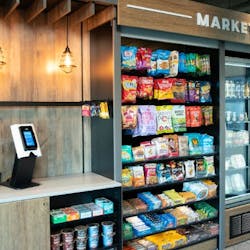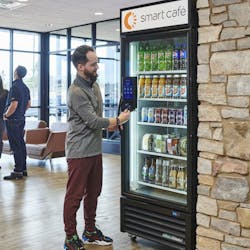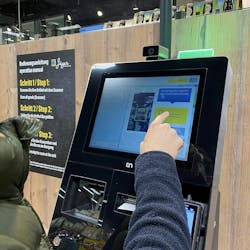There’s a lot to learn by looking outside of the industry for ideas on how to enhance the micro market segment. In fact, since the inception of micro markets, operators have been told to think of this new concept as a small retail store, quite unlike the vending machine.
Because operators have been told to think and act like retailers in their micro markets, it is essential to look at the convenience store (c-store), restaurant and grocery channels for ways to enrich micro market sales and improve the micro market experience.
The closest model
First and foremost, operators should look at the c-store segment, as it is the closest model, and opponent, to a micro market. In fact, micro market operators should be visiting this competition on a regular basis, says Greg McCall, vice president of Five Star Food Service. He notes that operators can gain valuable information from stepping into a c-store and analyzing several things: pricing, promotions and merchandising. “Pricing by category is an idea we took from c-stores,” he said. “It’s important to see how that segment prices their beverages and their subcategories, too.” McCall encourages operators to look at the types of beverages offered and the pricing structure of the items. Micro market items should be priced between vending and c-stores.
Next he looks at the promotional strategies the c-store is using. “We want to know what kind of discount they are offering and if we are providing a similar deal,” he said. “2-for” offers don’t work in micro markets, Five Star discovered, but its invaluable to know what the competition is offering regardless.
The company also watches loyalty programs in c-stores. “Every c-store has a loyalty program of some type now and if we are going to compete, we have to make sure we are offering a good program, too,” McCall commented.
Lastly the company looks at merchandising in c-stores for comparison to its own micro market merchandising. “We walk the store and we compare what we’re doing. We also look at counter merchandisers at the point of sale, as well as shipper programs, where manufacturers ship the product in a stand, making it easy for an operator to set up,” said McCall.
Kevin Searcy, president of deORO Markets, says that’s a great idea for operators. “Micro markets are great for impulse buys, and c-stores have developed that concept very well.” He recommends placing shelving around and under the payment kiosk. Searcy points to the wild success one operator had with impulse merchandising. “I have an operator who had an energy shot product that wasn’t selling in his machines, so he decided to place it down the side of the kiosk in his micro markets and he made a large profit that way because people are willing to spend more in micro markets,” he said. “The impulse buy made it possible for this operator to sell a product that wasn’t moving in vending.”
According to Kevin Bailey, president of Breakroom Provisions, c-stores are a treasure trove of information and a place from which operators can get ideas. “Companies such as Wawa, QuikTrip and Sheetz have elevated convenience retailing to an art form,” said Bailey. He suggests that operators look to this channel for effective graphics and signage, digital signage, product mix and trends, fixturing, loyalty programs and store layout and flow ideas.
One aspect of c-stores that operators should stay away from, however, is copying c-store layout directly. While c-stores have many rows of product in a ‘U’ or ‘L’ shape, Searcy believes micro markets do not benefit from that structure. “We noticed there was bottle necking in the corner and sales decreased in those areas because in a micro market no one wants to stand behind someone looking into the corner.” He also warns against making a micro market feel like a c-store. “I’ve gone into micro markets that have felt like gas stations and that’s not the feeling you want to convey,” he said. “You want to create an atmosphere with tables and chairs — a place to relax.”
Creating a welcoming atmosphere is key, says Elyssa Allahyar-Steiner, VP of marketing and sales at Avanti Markets. “If we look at cafés, we see people go there to work and set up their computer for the day or a couple hours and why is that?” she asked. “Well, there is free Wi-Fi in most cases, music playing in the background, the atmosphere is calm and it can allow people to focus outside of the four walls that make up their office.” Rather than looking to c-stores for atmosphere, operators should be looking at cafés and restaurants for better understanding the “experience” that consumers are looking for, including lounge areas, coffee tables and décor.
“Not everything in c-stores will be relevant to micro markets, but some stuff is, so absolutely operators should look at that channel,” said McCall.
Think outside the box
Outside of directly visiting c-stores, McCall notes that Five Star looks at c-store data from marketing research firm IRI. The firm publishes rankings of the top-selling items in c-stores by category, which helps Five Star know what their competition is selling and introduces them to new items.
The data is manufacturer-provided, specifically tailored to the region in which Five Star operates. This helps the company narrow down flavors and snack types that are popular in their area, as opposed to items that are trending elsewhere. “Though it comes out monthly, we look at this data quarterly to make sure we are in line with our competition,” he said. “It’s something we can get directly from our manufacturers for no cost. In between, we look at our own data to see what’s selling and what’s not.”
The company also follows c-store daily and weekly newsletters. McCall recommends subscribing to several c-store trade magazines, too.
Patrick McMullan, chief operating officer of Three Square Market, says that getting data from c-stores is just one way of thinking outside of the box. “I have an operator who uses a marketing campaign based on c-stores that works really well,” he said. “He campaigns that his micro markets are ‘5x5’, meaning that they are five steps from the employee’s desk and five cents cheaper than the nearest c-store. And he is constantly checking c-store pricing to make sure he stands by that.”
McMullan also says that operators can get an edge over c-stores by looking at the fresh food items they offer and then offering better. “We have another operator who partners with a really popular deli in St. Louis to offer sandwiches, salads, soups and more. He has been able to market the fact that he is bringing the deli to the office,” said McMullan. “He is offering a better product than the c-store. It not only has a better appeal but is more successful because it’s what the employees want in their breakroom. They wouldn’t have been able to get that experience without going to the deli directly.”
Gain from grocery and restaurants
Micro market operators can look outside of the c-store industry, too. In fact, grocery stores and restaurants — including fast-food — are other viable places to get ideas.
Five Star’s McCall uses grocery stores to see what products are popular here and now, paying close attention to beverages. “I will watch products in grocery stores and then talk with our distributors to try and get them in our micro markets,” he said. Five Star has been successful in getting Sparkling ICE, AriZona Beverages, Bolthouse Farms juices and Sabra Hummus in its micro markets from retail.
Other than overall trends, grocery offers ideas on loyalty programs and impulse merchandising, too. Searcy recalls one operator of his who places twelve-packs of soda near the exit of the micro market — a concept taken from retail. “I know that although it doesn’t greatly increase sales for him, offering a twelve-pack is a convenience factor for the customer so perhaps they don’t have to stop at the store on their way home to pick it up,” he said.
Grocery, while important, caters to a different consumer than micro markets, McCall said. “The grocery customer is going there and spending $300 and planning their visit. In the micro market, it’s convenience and impulse.” McCall looks at quick-service restaurants for ideas in marketing. Five Star creates a rib-based promotion around McDonald’s McRib limited-time offering. “We use the momentum that surrounds fast-food limited-time offerings,” said McCall. The company is currently working to build a breakfast menu paired with coffee, a fast-food trend that is ongoing.
There are endless opportunities for micro markets to provide a one-stop shop for customers, but operators need to be willing to think like retailers. “Soak up the data and concepts that are applicable to the micro market industry, consider the possible application to your markets and implement those that make sense,” said Bailey. “With micro market competition heating up, having micro markets that use the proven concepts of other related industries is absolutely necessary.”
When it all comes down to it, micro market operators should focus on the facts, says Joe Hessling, CEO of 365 Retail Markets. “Identifying trends is a vital skill for a successful micro market operator and in vending terms, a trending item will “turn” more than a low performing item, giving the operator more product movement. Whether the identification of these trends comes from industry reports or simply walking the aisles of c-stores or grocery stores, research is important.”
Micro market operators looking outside of the industry have a better chance of improving their micro markets and providing a complete consumer experience.




